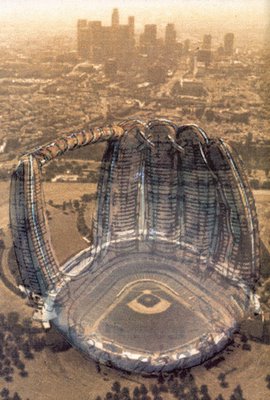Scientists are now "imploring governments to decide on a strategy for dealing with it" – because the earth is in danger...! Again.
Only this time, the story has inspired an architectural idea.

[Image: The Roman Coloseum, photographed from space].
The exact trajectory of Apophis is apparently well-calculated (albeit with a few minor blindspots, such as whether or not it will actually come anywhere near the planet).
But surely you could just use a bigger computer – or cancel your lab workers' vacation time – and soon you'd know, to the exact square-meter – to the very time of day! – where Apophis will land.
At which point we'll build a huge baseball glove.

[Image: Michael Sorkin, Chavez Ravine, Los Angeles (with a new Dodgers Stadium); from the excellent, Christmas gift-worthy Wiggle].
Massive amounts of fiber-glass padding and reinforced concrete – plus entire subterranean, manmade lakes – will deflect the tectonic pressure of the asteroid's impact, softening the outward-rippling aftershocks; the glove will even collapse in upon itself, blocking the explosion of dust that would otherwise cloud the atmosphere.
Best of all, we'll know the exact moment of arrival, so the whole thing will be captured on film. A billion dollars' worth of ad time has already been sold.
But maybe the calculations are off, you're thinking. Perhaps we know Apophis will hit in 2029 – but what if it's outside Springdale, Utah, or somewhere in the Gobi Desert, maybe even in the middle of the sea.
No problem: we'll just build huge, kilometer-wide baseball gloves all over the planet. Floating through the Pacific. In 2016 an artist will apply for a one-year residency on one of the floating gloves, and her notes and photographs will be published the next year to great critical and commercial acclaim.
Then, in 2029, live on TV: catastrophe averted.
The glove-stadium actually works.

[Image: Planet Glove, by BLDGBLOG].
(Inspired by a brief discussion on Archinect; see also BLDGBLOG's earlier post, The Torino Scale, for more on the architecture of impact).
No comments:
Post a Comment